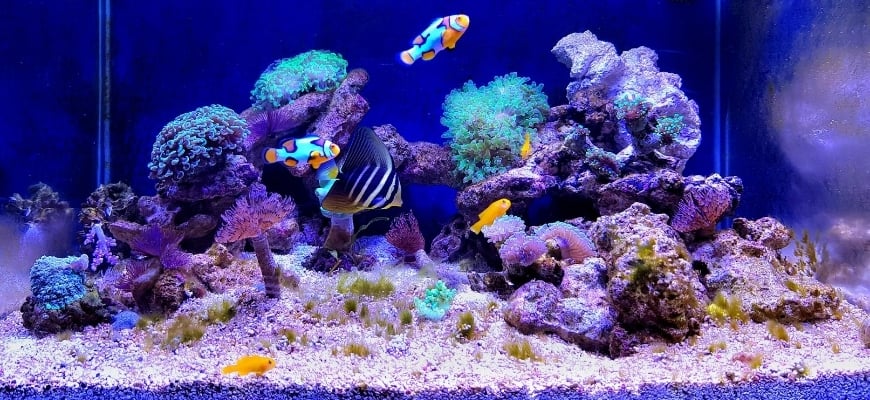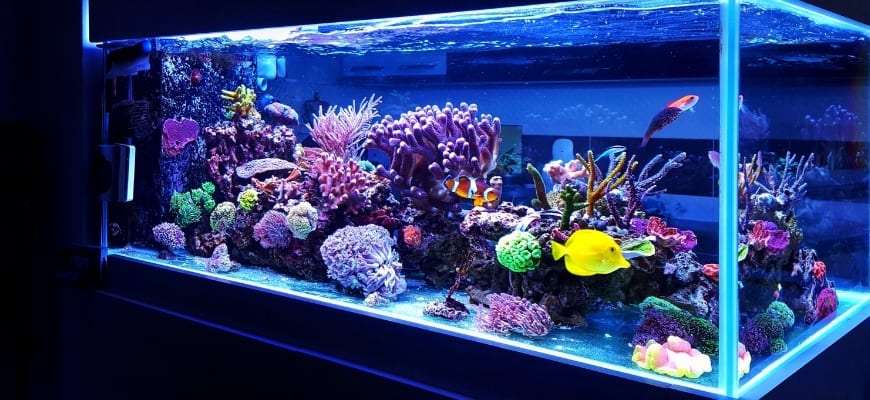Take a close look at any fish swimming underwater, and you’ll spot the unmistakable signs of its gills opening and closing. You remember your science classes in elementary school, so you know that fish move their gills to breathe. But what do they breathe, exactly?
This seems like a very intuitive question, but when water consists of just 1% of dissolved oxygen, it is a valid one. Do fish actually need oxygen to survive? How do they get the oxygen they need? In this article, we address these questions and more.
Spoiler alert: Fish, like all other living things, need oxygen to survive.
Why Do Fish Need Oxygen?
Now that we’ve established that all species of fish do indeed need oxygen, let’s take a look at what it is used for. All living things, fish and plants included, use oxygen in a process known as aerobic respiration. In this process, oxygen is used to break down food molecules to release energy, which is in turn used to carry out all living processes. Think eating, growing, swimming, the works.
As you may imagine, aerobic respiration is absolutely crucial to a fish’s survival – and by extension, oxygen is too. But it’s not just fish that require oxygen. Nitrifying bacteria do too. In the absence of oxygen, the nitrogen cycle is disrupted as these bacteria are unable to convert ammonia from fish into nitrates and nitrites. This in turn creates toxic water conditions for your fish.
A tank that lacks oxygen would force its inhabitants to undergo anaerobic respiration. This is a process that only produces between 5-8% of the energy produced in aerobic respiration, so it is not a sustainable strategy for long-term survival.
Therefore, fish absolutely need oxygen to survive. A lack of oxygen harms your fish directly and indirectly. Direct implications include suffocation and stunted growth, while indirect implications include unstable water conditions and their associated illnesses.
Where Do Fish Get Oxygen From?
Given the importance of oxygen, it is worth taking a look at where fish get oxygen from. In the vast majority of cases, fish meet their respiratory needs using dissolved oxygen in tanks. This is a process where oxygen molecules from the atmosphere dissolve naturally in the water.
The air we breathe is composed of approximately 20% oxygen and 80% nitrogen. However, only a small fraction dissolves in water.
Meanwhile, if you keep aquatic plants in your tank, you can rest assured knowing that oxygen is released by plants as a byproduct of photosynthesis. Therefore, housing aquatic plants in your tank might be a good long-term move.
Last but not least, some fish have no need to rely entirely on dissolved oxygen to breathe. These fish are able to inhale oxygen from the atmosphere using labyrinth organs. If you’ve ever spotted a betta fish taking gulps of air on the surface of the tank, that’s exactly what’s happening.
Factors Affecting Oxygen Consumption in Fish
Several factors affect the rate of oxygen consumption in fish. Knowing how much oxygen your fish needs allows you to adequately meet their needs and keep them healthy.
Size
Generally speaking, larger fish have a higher oxygen requirement. Large fish tend to consume a greater total amount of oxygen compared to small fish. However, smaller fish consume more oxygen per unit of body weight, compared to their larger counterparts.
A study by Auburn University reports that 10-gram channel catfish use approximately 1,050 milligrams of oxygen per kilogram of body weight in an hour, while a 500-gram fish only consumes 480 milligrams of oxygen per kilogram of body weight in the same timeframe.
However, these figures show that the 10-gram channel fish would only consume a total of 10.5 milligrams of oxygen per hour, despite their high requirements per unit of body weight. Meanwhile, the larger, 500-gram fish will use a total of 240 milligrams of oxygen every hour.
Species

Generally speaking, an oxygen level of 8.3 ppm (parts per million) is sufficient for most freshwater tanks. This is because most fish species breathe through oxygen in water.
However, some types of fish have evolved to survive in low-oxygen conditions. These species include aquarium catfish, gouramis, Siamese fighting fish, and loaches.
Many of these fish are able to breathe atmospheric oxygen through the blood vessels in their skin, allowing them to thrive in muddy riverbanks with a poorly oxygenated water supply. Others, such as the Siamese fighting fish, have evolved labyrinth organs that allow them to gulp air from the surface of the tank.
Be that as it may, do note that most freshwater and tropical fish breathe solely through their gills.
Metabolic Rate
Metabolic rate measures how much food is being converted into energy within a given period. The higher the metabolic rate of your fish, the more oxygen it requires. Generally, your fish will consume a greater amount of oxygen under the following circumstances:
– Right after a heavy meal
– When it is physically active
– During reproduction
These circumstances necessitate a greater rate of respiration, so more oxygen will be used. Metabolic rate is also affected by temperature, which we will discuss below.
Temperature
Temperature is perhaps one of the key factors affecting oxygen consumption in fish. At low temperatures, fish enter a state of near-hibernation, where they are able to survive with minimal metabolic activity. This means that fish require less oxygen when temperatures are low.
However, things change rapidly as temperatures start to rise. The oxygen requirements of fish will double with every 50°F increase in water temperature. Warm water can precipitate an increase in metabolism, meaning that your fish will require more oxygen to sustain its life processes.
Because fish in warmer fish tanks need more oxygen, it is important that you keep your system well-oxygenated in the summer – especially at night, when aquatic plants stop releasing oxygen.
How To Increase Oxygen Levels In Your Tank
Maintaining an adequate amount of dissolved oxygen in your tank is crucial in keeping it healthy. We would highly recommend using oxygen meters to ensure that the oxygen levels in your tank are up to mark. A lack of oxygen could spell trouble for your fish.
Thankfully, there are a few things you can do to increase the oxygen levels in your tank should the need arise. Here are a few things you can do!
Increase the Surface Area of Your Tank
Oxygen enters your tank via the topmost layer of water, so increasing the surface area of your tank is one of the most straightforward ways of increasing its oxygen levels.
When you increase the surface area of your tank, you increase the amount of water that is directly exposed to atmospheric air, allowing more oxygen to dissolve in it.
One thing to avoid about employing this strategy is going too far. While it can be tempting to focus solely on maximizing surface area, most fish require a comfortable depth in their aquarium to thrive.
Not all areas of your tank would achieve 100% oxygen saturation under these circumstances, but that’s perfectly normal.

Aerate the Water Via Surface Agitation
Another way of increasing oxygen levels in your tank is by aerating the water via surface agitation. You can do so using wavemakers, spray bars, aquarium bubblers, or even Hang-on-Back (HOB) filters. Doing so can make a difference, as agitated water tends to contain a greater amount of dissolved oxygen.
Check out this article to learn the differences between a HOB and a canister filter, as the type of filter you choose will impact its effectiveness in aerating your water.
These devices work by allowing more water to come into contact with the atmosphere. Doing so accomplishes two things: 1. It allows more carbon dioxide in the water to escape and 2. It allows more oxygen to dissolve in your tank water.
Consider Lowering the Water Temperature
Something else to take note of is elevated water temperature. The higher the temperature of the water in your tank, the lower its ability to effectively dissolve oxygen. In other words, hotter water tends to have less oxygen.
This is bad news for the fishing industry, as global warming is taking place at an alarming rate. It is estimated that for every degree Celsius (1.8 degrees Fahrenheit) of atmospheric warming, the fishing industry would see a loss of an estimated 3.4 million metric tonnes of potential catches.
Given this phenomenon, it is essential for you to monitor your aquarium water with a reliable thermometer. Different freshwater fish will have a range of preferred temperatures, and we recommend sticking to temperature levels on the cooler (but comfortable) end of the scale.
You might also recall that fish have a greater need for oxygen as the water temperature increases. This means the gap between the amount of oxygen dissolved in water vs. the amount your fish requires narrows as temperature rises. This makes temperature control all the more important.
Stock Your Tank Appropriately
Last but not least, you need to stock your tank appropriately! An overstocked tank is a recipe for disaster, even if it’s filled with mild-mannered fish.
Think about it this way: Every additional fish you introduce to your tank is going to have its own oxygen requirements, but there’s only so much dissolved oxygen your water can accommodate.
The situation worsens at night, when the aquatic plants in your tank stop releasing oxygen as a byproduct of photosynthesis and instead, respire using oxygen as well. This increases the demand for dissolved oxygen in your system.
Addressing this problem requires stocking your tank sensibly. The go-to guideline is the “one inch of fish per gallon” rule, but this article provides more in-depth guidelines on stocking your aquarium!
FAQ
Do Fish Get Out of Breath?
Yes, fish can absolutely get out of breath if oxygen levels are insufficient. If this is the case, you will likely see them gasping for air on the surface of the water, or observe their gills moving quickly in an effort to gain more oxygen.
However, it is important to note that fish can encounter mild levels of oxygen deprivation without exhibiting any of the signs listed above. If oxygen levels in your tank are insufficient, but not dangerously low, your fish will still be able to breathe. However, other aspects of their well-being, such as growth, might be affected.
What Does 100% Air Saturation Mean?
At 100% air saturation, the water is holding as many dissolved gas molecules as it can in equilibrium.
Therefore, a body of water with 100% oxygen saturation will contain the maximum amount of oxygen molecules it can hold, given the environmental conditions.
Does All Water Have 100% Air Saturation?
No, not all water will have 100% air saturation levels. Low-oxygen areas can sometimes form in deeper waters.
How Do Low-Oxygen Areas Form?
Low oxygen areas can form in deep waters for a variety of reasons. First of all, photosynthesis is less likely to take place in deeper waters simply because less light is able to penetrate those depths.
This means that algae and phytoplankton do not release oxygen in deep waters, causing a decrease in oxygen levels.
Secondly, more microbial decomposition takes place in deeper waters. The bacteria that break down organic matter require oxygen to do so effectively. While decomposition can take place in the absence of oxygen, this process is less efficient and can release a foul odor.
Conclusion
To circle back to the question that started it all: Yes! Fish definitely need oxygen, and will require different amounts of oxygen depending on their species, metabolic rate, and body temperature.
As a responsible fish keeper, you should absolutely ensure that the dissolved oxygen level in your tank is sufficient for your fish, as this will impact their general health and well-being.
Did you enjoy this article? If you did, share it with someone else who might benefit from it!
